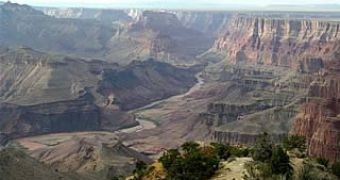Humans evolved from apes in a savanna environment. But what forced this environmental change? In a study published in the journal "Geotimes", a husband-and-wife team of geologists, at the University of Utah, shows that the uplift of the mountains from East Africa determined our emergence on Earth.
"Tectonics [movement of Earth's crust] was ultimately responsible for the evolution of humankind", wrote Royhan and Nahid Gani of the university's Energy and Geoscience Institute.
They show that the rapid uplift of mountains and highlands, going from Ethiopia to South Africa, stopped ocean moisture, turning rain forests into dry woodlands and savannas that favored terrestrial life and bipedalism (walking on two feet).
The "Wall of Africa", a 3,700-mile (6,000 km)-long stretch of highlands and mountains parallel to the East African Rift valley, is the place where most human ancestors species have been discovered.
"Because of the crustal movement or tectonism in East Africa, the landscape drastically changed over the last 7 million years. That landscape controlled climate on a local to regional scale. That climate change spurred human ancestors to evolve from apes", said Royhan, a research assistant professor of civil and environmental engineering.
Early humans split from the common lineage with the chimps about 7 to 4 million years ago. "The earliest undisputed hominin was Ardipithecus ramidus 4.4 million years ago. The earliest Homo arose 2.5 million years ago, and our species, Homo sapiens, almost 200,000 years ago. Much previous discussion of how climate affected human evolution involves global climate changes, such as those caused by cyclic changes in Earth's orbit around the sun, and not local and regional climate changes caused by East Africa's rising landscape", said Royhan.
The tectonic forces shaping East Africa started at least in the past 45 million years, and managed to force apart the African and Arabian tectonic plates, resulting the Red Sea, Gulf of Aden and the Great Rift Valley, going from Syria to southern Africa. The African Rift, a valley bordered by high plateaus a few tens to few hundreds of km wide, goes from the Ethiopian Plateau to South Africa's Karoo Plateau. The Rift is up to 600 km (370 mi) wide and comprises mountains that reach 6,450 m (19,340 ft) at Mount Kilimanjaro.
The rift "is characterized by volcanic peaks, plateaus, valleys and large basins and freshwater lakes, including sites where many fossils of early humans and their ancestors have been found", said Nahid, a research scientist.
"Although the Wall of Africa started to form around 30 million years ago, recent studies show most of the uplift occurred between 7 million and 2 million years ago, just about when hominins split off from African apes, developed bipedalism and evolved bigger brains", wrote the authors.
"Nature built this wall, and then humans could evolve, walk tall and think big. The answer is the variable landscape and vegetation resulting from uplift of the Wall of Africa, which created a topographic barrier to moisture, mostly from the Indian Ocean and dried the climate. Contrary to those who cite global climate cycles, the climate changes in East Africa were local and resulted from the uplift of different parts of the wall at different times", said Royhan.
"The change from forests to a patchwork of woodland and open savannah did not happen everywhere in East Africa at the same time, and the changes also happened in East Africa later than elsewhere in the world."
The highest part of the Wall of Africa is the Ethiopian Plateau, about 300-mile-by-300-mile (500 km by 500 km). The plateau got is current average elevation of 8,200 ft (2,730 m) about 25 million years ago. The team investigated rates at which the Blue Nile River cut down into this plateau, digging a canyon as big as the famous Grand Canyon in US.
Low-to-moderate incision/uplift occurred 29 to 10 million years ago and 10 to 6 million years ago, but the fastest uplift of the plateau (some 3,200 ft or 1,060 m) occurred 6 to 3 million years ago.
Other studies revealed that the Kenyan Rift formed 7 to 2 million years ago, mountains in Tanganyika and Malawi 5 to 2 million years ago, and the Karoo plateau in the last 5 million years.
"Clearly, the Wall of Africa grew to be a prominent elevated feature over the last 7 million years, thereby playing a prominent role in East African aridification by wringing moisture out of monsoonal air moving across the region. That period coincides with evolution of human ancestors in the area", wrote the authors.
"The earliest undisputed evidence of true bipedalism (as opposed to knuckle-dragging by apes) is 4.1 million years ago in Australopithecus anamensis, but some believe the trait existed as early as 6 million to 7 million years ago", pointed Royhan.
The varied landscapes induced by tectonics, from lake basins to valleys, mountains, grasslands, woodlands "could also be responsible, at a later stage, for hominins developing a bigger brain as a way to cope with these extremely variable and changing landscapes in which they had to find food and survive predators", signaled the authors.

 14 DAY TRIAL //
14 DAY TRIAL //